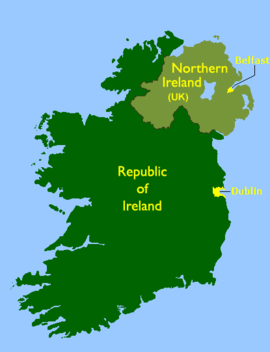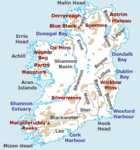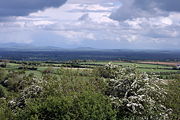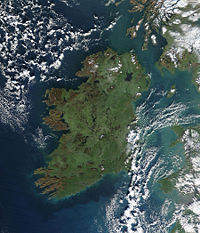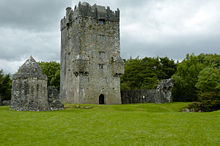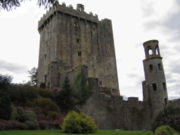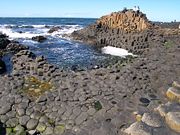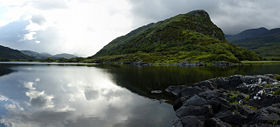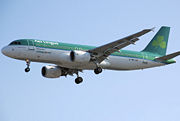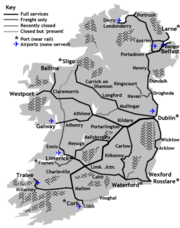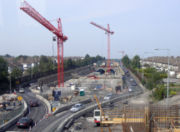Ireland
2008/9 Schools Wikipedia Selection. Related subjects: Europe; European Countries
 Northwest of continental Europe with Great Britain to the east |
|
| Geography | |
|---|---|
| Location | Western Europe |
| Area | 84,412 km² (32,591 sq mi) |
| Rank | 20th |
| Highest point | Carrauntoohil (1,038 m (3,406 ft)) |
| Administration | |
| Largest city | Dublin |
| Constituent country | Northern Ireland |
| Largest city | Belfast |
| Demographics | |
| Population | approximately 6 million (as of 2007) |
| Density | /km² |
| Ethnic groups | Irish |
Ireland (pronunciation /ˈaɾlənd/ or /ˈaɪɾlənd/; Irish: Éire; Ulster Scots: Airlann) is one of the two main islands (and second largest) of the British Isles, the third largest island in Europe, and the twentieth-largest island in the world. It lies to the north-west of continental Europe and is surrounded by hundreds of islands and islets. To the east of Ireland, separated by the Irish Sea, is the island of Great Britain. Politically, the state Ireland (described as the Republic of Ireland in cases of ambiguity) covers five-sixths of the island, with Northern Ireland, part of the United Kingdom, covering the remainder in the north-east.
The population of the island is slightly over 6 million (2007), with 4.4 million in the Republic of Ireland (1.7 million in Greater Dublin) and an estimated 1.75 million in Northern Ireland (800,000 in Greater Belfast). This is a significant increase from a modern historical low in the 1960s, but still much lower than the peak population of over 8 million in the early 19th century, prior to the Great Hunger (1840s famine).
The name Ireland derives from the name Ériu (in modern Irish, Éire) with the addition of the Germanic word land. Most other western European names for Ireland derive from the same source, such as French Irlande, Spanish, Italian, Romanian and Portuguese Irlanda, German Irland and Dutch Ierland.
Political geography
The island of Ireland has two distinct jurisdictions:
- Ireland (description is the Republic of Ireland), a sovereign state, covers five-sixths of the island. Its capital is Dublin.
- Northern Ireland, part of the United Kingdom of Great Britain and Northern Ireland, covers the remaining sixth. Its capital is Belfast.
For the political history of the island, see History of Ireland.
| Province | Population | Area (km²) | Largest city |
|---|---|---|---|
| 503,083 | 17,713 | Galway | |
| 2,292,939 | 19,774 | Dublin | |
| 1,172,170 | 24,608 | Cork | |
| 1,993,918 | 24,481 | Belfast |
Traditionally, Ireland is subdivided into four provinces: Connacht, Leinster, Munster and Ulster; and, in a system developed between the 13th and 17th centuries, 32 counties. Twenty-six of the counties are in the Republic of Ireland, and the remaining six (all in Ulster) are in Northern Ireland. Notably, based on boundaries established in the Early Modern period, Ulster and Northern Ireland are neither synonymous nor co-extensive, as three counties of Ulster ( Cavan, Donegal and Monaghan) are part of the Republic. Nonetheless, 'Ulster' is often used colloquially as a synonym for Northern Ireland. Counties Dublin, Cork, Limerick, Galway, Waterford and Tipperary have been broken up into smaller administrative areas, but are still considered by Ordnance Survey Ireland to be official counties. The counties in Northern Ireland are no longer used for local government, although their traditional boundaries are still used in sports and in some other cultural and ceremonial areas.
All-island institutions
Despite the constitutional division of Ireland, the island does operate as a single entity in a number of areas. With a few notable exceptions, the island operates as a single unit in all major religious denominations and in many economic fields despite using two different currencies. There are also significant all-island dimensions to sports such as hurling, gaelic football, rugby, golf, cricket and hockey.
The notable exception to this is soccer (where the previously all-island Irish Football Association following partition retained control of soccer only in Northern Ireland, with a separate Football Association of Ireland being formed for the remainder of the island) although an all-Ireland club cup competition, the Setanta Cup, was created in 2005. The creation of an all-island Association football league and a single international team (which is the case for rugby union) has been publicly touted by various prominent figures on the island in recent years, such as Irish government minister Dermot Ahern. More recently, FAI chief executive John Delaney believes there will be an all-Ireland league, but not before 2012, as a contract involving the Eircom League and the FAI runs to 2011. There is currently at least one player from Northern Ireland regularly appearing in the Republic of Ireland's squad, a practice that the latter's governing institution and the Irish government claim is permitted by the Belfast Agreement - although in reality there was apparently nothing to prevent the FAI from selecting players from Northern Ireland before the Agreement, since the Republic of Ireland's citizenship laws already extended north of the border. Nonetheless, Northern Ireland's governing body, the IFA, has raised the matter with the world governing body, FIFA, which appears to have ruled in favour of the Republic (although the matter remains unclear and therefore unresolved).
All major religious bodies are organised on an all-Ireland basis, such as the Roman Catholic Church, the Methodist Church in Ireland, the Church of Ireland/Anglican Church and the Presbyterian Church in Ireland. Some trade unions are also organised on an all-island basis and associated with the Irish Congress of Trades Unions (ICTU) in Dublin, while others in Northern Ireland are affiliated with the Trades Union Congress (TUC) in the United Kingdom, and some affiliate to both — although such unions may organise in both parts of the island as well as in Great Britain. The Union of Students in Ireland (USI) organises jointly in Northern Ireland with the National Union of Students of the United Kingdom (NUS), under the name NUS-USI.
The Belfast Agreement provides for all-Ireland governance in various guises. For example, a North-South Ministerial Council was established as a forum in which ministers from the Irish government and the Northern Ireland Assembly can discuss matters of mutual concern and formulate all-Ireland policies in twelve "areas of co-operation", such as agriculture, the environment and transport. Six of these policy areas have been provided with implementation bodies, an example of which is the Food Safety Promotion Board. Tourism marketing is also managed on an all-Ireland basis, by Tourism Ireland.
Two political parties, Sinn Féin and the Irish Green Party, contest elections and hold parliamentary seats in both jurisdictions. The largest party in the Republic of Ireland, Fianna Fáil, considered extending its organisation into Northern Ireland, perhaps via a merger with another political party, the Social Democratic and Labour Party (SDLP).
A significant number of newspapers on the island are circulated in both jurisdictions, e.g., the Irish Times, The Irish Independent, The Sunday Business Post, The Irish Star, Lá Nua etc. and report news on an all-Ireland basis. Others include Irish editions of tabloids such as : Ireland-based The Sunday World and the Irish editions of UK-based The News of The World. The Irish Times includes news concerning Northern Ireland in its "Home" section, despite the fact that it is based in the Republic. Notable exceptions to this include, The Belfast Telegraph and Sunday Life (although these titles are owned by Ireland-based Independent News and Media, publisher of The Irish Independent.) Other Irish Newspaper publishers like Independent News and Media and Thomas Crosbie Holdings publish local titles for townlands in both parts of Ireland. Furthermore, most of the television stations based on the island broadcast across the whole island, such as RTÉ, TG4 and UTV (although signals may be relatively weaker in more remote areas).
An increasingly large amount of commercial activity operates on an all-Ireland basis, a development that is in part facilitated by the two jurisdictions' shared membership of the European Union. There have been calls for the creation of an "all-island economy" from members of the business community and policy-makers on both sides of the border, so as to benefit from economies of scale and boost competitiveness in both jurisdictions. This is a stated aim of the Irish government and nationalist political parties in the Northern Ireland Assembly. One commercial area in which the island already operates largely as a single entity is the electricity market. and there are plans for the creation of an all-island gas market.
17 March is celebrated throughout the island of Ireland as St. Patrick's Day.
Physical geography
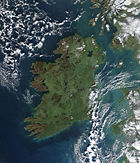
A ring of coastal mountains surrounds low central plains. The highest peak is Carrauntoohil ( Irish: Corrán Tuathail) in County Kerry, which is 1,038 m (3,406 ft). The River Shannon, at 386 km (240 miles) is the longest river in Ireland. The island's lush vegetation, a product of its mild climate and frequent but soft rainfall, earns it the sobriquet "Emerald Isle". The island's area is 84,412 km² (32,591 square miles).
Ireland's least arable land lies in the south-western and western counties. These areas are largely mountainous and rocky, with dramatic green vistas, hence the attributive name "the Emerald Isle".
Climate
Overall, Ireland has a mild, but changeable, Oceanic climate with few extremes. The warmest recorded air temperature was 33.3 °C (91.94 °F) at Kilkenny Castle, County Kilkenny on 26 June 1887, where as the lowest recorded temperature was −19.1 °C (−2.38 °F) at Markree Castle, County Sligo on 16 January 1881.
Other statistics show that the greatest recorded annual rainfall was 3,964.9 mm (156.1 in) in the Ballaghbeena Gap in 1960. The driest year on record was 1887, with only 356.6 mm (14.0 in) of rain recorded at Glasnevin, while the longest period of absolute drought was in Limerick where there was no recorded rainfall over 38 days during April and May of 1938.
The climate is typically insular, and as a result of the moderating moist winds which ordinarily prevail from the South-Western Atlantic, it is temperate, avoiding the extremes in temperature of many other areas in the world at similar latitudes.
Precipitation falls throughout the year, but is light overall, particularly in the east. The west, however, tends to be wetter on average and prone to the full force of Atlantic storms, more especially in the late autumn and winter months, which occasionally bring destructive winds and high rainfall totals to these areas, as well as snow and hail. The regions of North Galway and East Mayo have the highest incidents of recorded lightning annually (5 to 10 days per year). Munster in the south records the least snow with Ulster in the north more prone to snow. Some areas along the south and southwest coasts have not had any lying snow since February 1991.
Inland areas are warmer in summer, and colder in winter - there are usually around 40 days of below freezing temperatures (0 °C/32 °F) at inland weather stations, but only 10 days at coastal stations. Ireland is sometimes affected by heat waves, most recently 1995, 2003, 2006.
Geology
Geologically the island consists of a number of provinces - in the far west around Galway and Donegal is a medium to high grade metamorphic and igneous complex of Caledonide (Scottish Highland) affinity. Across southeast Ulster and extending southwest to Longford and south to Navan is a province of Ordovician and Silurian rocks with more affinities with the Southern Uplands province of Scotland. Further south, there is an area along the Wexford coast of granite intrusives into more Ordovician and Silurian rocks with a more Welsh affinity.
In the southwest, around Bantry Bay and the mountains of Macgillicuddy's Reeks, is an area of substantially deformed but only lightly metamorphosed Devonian-aged rocks.
This partial ring of "hard rock" geology is covered by a blanket of Carboniferous limestone over the centre of the country, giving rise to the comparatively fertile and famously "lush" landscape of the country. The west coast district of The Burren around Lisdoonvarna has well developed karst features. Elsewhere, significant stratiform lead-zinc mineralisation is found in the limestones (around Silvermines and Tynagh).
Hydrocarbon exploration is continuing. The first major find was the Kinsale Head gas field off Cork/ Cobh by Marathon Oil in the mid-1970s. More recently, in 1999, Enterprise Oil announced the discovery of the Corrib Gas Field. This has increased activity off the west coast in parallel with the " West of Shetland" step-out development from the North Sea hydrocarbon province. Exploration continues, with a frontier well planned north of Donegal for August 2006 and continuing drilling of prospects in the Irish Sea and St Georges Channel.
Wildlife
Ireland has fewer animal and plant species than either Britain or mainland Europe because it became an island shortly after the end of the last glacial period, about 10,000 years ago. Many different habitat types are found in Ireland, including farmland, open woodland, temperate broadleaf and mixed forests, conifer plantations, peat bogs, and various coastal habitats. According to the WWF, the territory of Ireland can be subdivided into two ecoregions: the Celtic broadleaf forests and North Atlantic moist mixed forests.
Fauna
Only 26 land mammal species are native to Ireland, because it was isolated from Europe by rising sea levels after the Ice Age. Some species, such as the red fox, hedgehog, and badger are very common, whereas others, like the Irish hare, red deer and pine marten are less so. Aquatic wild-life, such as species of turtle, shark, whale, and dolphin, are common off the coast. About 400 species of birds have been recorded in Ireland. Many of these are migratory, including the Barn Swallow. Most of Ireland's bird species come from Iceland, Greenland, Africa among other territories. There are no snakes in Ireland and only one reptile (the common lizard) is native to the country. Extinct species include the great Irish elk, the wolf, the great auk, and others. Some previously extinct birds, such as the Golden Eagle, have recently been reintroduced after decades of extirpation.
Agriculture drives current land use patterns in Ireland, limiting natural habitat preserves, particularly for larger wild mammals with greater territorial needs. With no top predator in Ireland, populations of animals that cannot be controlled by smaller predators (such as the fox) are controlled by annual culling, i.e. semi-wild populations of deer.
Flora
Phytogeographically, Ireland belongs to the Atlantic European province of the Circumboreal Region within the Boreal Kingdom. Until mediæval times Ireland was heavily forested with oak, pine, beech and birch. Forests now cover about 9% (4,450 km² or one million acres) of the land. Because of its mild climate, many species, including sub-tropical species such as palm trees, are grown in Ireland. Much of the land is now covered with pasture, and there are many species of wild-flower. Gorse ( Ulex europaeus), a wild furze, is commonly found growing in the uplands, and ferns are plentiful in the more moist regions, especially in the western parts of Ireland. It is home to hundreds of plant species, some of them unique to the island. The country has been "invaded" by some grasses, such as Spartina anglica.
The algal and seaweed flora is that of the cold-temperate. The total number of species is:- Rhodophyta: 264; Heterokontophyta: 152; Chloropyta: 114; Cyanophyta: 31 giving a total of 574. Rarer species include: Itonoa marginifera (J.Ag.) Masuda & Guiry); Schmitzia hiscockiana Maggs and Guiry; Gelidiella calcicola Maggs & Guiry; Gelidium maggsiae Rico & Guiry and Halymenia latifolia P.Crouan & H.Crouan ex Kützing. The country has been invaded by some algae, some of which are now well established: Asparagopsis armara Harvey - which originated in Australia and was first recorded by M. De Valera in 1939; Colpomenia peregrina Sauvageau - now locally abundant and first recorded in the 1930s; Sargassum muticum (Yendo) Fensholt - now well established in a number of localities on the south, west, and north-east coasts; Codium fragile ssp. fragile (formerly reported as ssp. tomentosum) - now well established. Codium fragile ssp. atlanticum has recently been established to be native, although for many years it was regarded as an alien species.
The impact of agriculture
The long history of agricultural production coupled with modern intensive agricultural methods (such as pesticide and fertiliser use) has placed pressure on biodiversity in Ireland. "Runoff" of contaminants into streams, rivers and lakes impact the natural fresh-water ecosystems. A land of green fields for crop cultivation and cattle rearing limits the space available for the establishment of native wild species. Hedgerows however, traditionally used for maintaining and demarcating land boundaries, act as a refuge for native wild flora. Their ecosystems stretch across the countryside and act as a network of connections to preserve remnants of the ecosystem that once covered the island. Subsidies under the Common Agricultural Policy which supported these agricultural practices are undergoing reforms. The CAP still subsidises some potentially destructive agricultural practices, however, the recent reforms have gradually decoupled subsidies from production levels and introduced environmental and other requirements.
Forest covers about 10% of the country, with most designated for commercial production. Forested areas typically consist of monoculture plantations of non-native species which may result in habitats that are not suitable for supporting a broad range of native species of invertebrates. Remnants of native forest can be found scattered around the country, in particular in the Killarney National Park. Natural areas require fencing to prevent over-grazing by deer and sheep that roam over uncultivated areas. This is one of the main factors preventing the natural regeneration of forests across many regions of the country.
History
A long cold climatic spell prevailed until the end of the last glacial period about 9,000 years ago, and most of Ireland was covered with ice. Sea-levels were lower then, and Ireland, as with its neighbour Britain, rather than being islands, were part of a greater continental Europe. Mesolithic stone age inhabitants arrived some time after 8000 BC. Agriculture arrived with the Neolithic circa 4500 to 4000 BC, when sheep, goats, cattle and cereals were imported from southwest continental Europe. At the Céide Fields in County Mayo, an extensive Neolithic field system - arguably the oldest in the world - has been preserved beneath a blanket of peat. Consisting of small fields separated from one another by dry-stone walls, the Céide Fields were farmed for several centuries between 3500 and 3000 BC. Wheat and barley were the principal crops.
The Bronze Age, which began around 2500 BC, saw the production of elaborate gold as well as bronze ornaments, weapons and tools. The Iron Age in Ireland was supposedly associated with people known as Celts. They are traditionally thought to have colonised Ireland in a series of waves between the 8th and 1st centuries BC, with the Gaels, the last wave of Celts, conquering the island and dividing it into five or more kingdoms. Many scientists and academic scholars now favour a view that emphasises cultural diffusion from overseas over significant colonisation such as what Clonycavan Man was reported to be. The Romans referred to Ireland as Hibernia and/or Scotia. Ptolemy in AD 100 records Ireland's geography and tribes. Native accounts are confined to Irish poetry, myth, and archaeology. The exact relationship between Rome and the tribes of Hibernia is unclear; the only references are a few Roman writings.
In medieval times, a monarch (also known as the High King) presided over the (then five) provinces of Ireland. These provinces too had their own kings, who were at least nominally subject to the monarch, who resided at Tara. The written judicial system was the Brehon Law, and it was administered by professional learned jurists who were known as the Brehons.
According to early medieval chronicles, in 431, Bishop Palladius arrived in Ireland on a mission from Pope Celestine I to minister to the Irish "already believing in Christ." (This was to convert the Celtic Church to Roman Catholicism). The same chronicles record that Saint Patrick, Ireland's patron saint, arrived in 432. There is continued debate over the missions of Palladius and Patrick, but the general consensus is that they both existed and that 7th century annalists may have mis-attributed some of their activities to each other. Palladius most likely went to Leinster, while Patrick is believed to have gone to Ulster, where he probably spent time in captivity as a young man.
The druid tradition collapsed in the face of the spread of the new religion. Irish Christian scholars excelled in the study of Latin and Greek learning and Christian theology in the monasteries that flourished, preserving Latin and Greek learning during the Early Middle Ages. The arts of manuscript illumination, metalworking, and sculpture flourished and produced such treasures as the Book of Kells, ornate jewellery, and the many carved stone crosses that dot the island. From the 9th century, waves of Viking raiders plundered monasteries and towns, adding to a pattern of endemic raiding and warfare. Eventually Vikings settled in Ireland, and established many towns, including the modern day cities of Dublin, Cork, Limerick and Waterford.
From 1169, Ireland was entered by Cambro-Norman warlords, led by Richard de Clare, 2nd Earl of Pembroke (Strongbow), on an invitation from the then King of Leinster. In 1171, King Henry II of England came to Ireland, using the 1155 Bull Laudabiliter issued to him by then Pope Adrian IV, to claim sovereignty over the island, and forced the Cambro-Norman warlords and some of the Gaelic Irish kings to accept him as their overlord. From the 13th century, English law began to be introduced. By the late thirteenth century the Norman-Irish had established the feudal system throughout most of lowland Ireland. Their settlement was characterised by the establishment of baronies, manors, towns and large land-owning monastic communities, and the county system. The towns of Dublin, Cork, Wexford, Waterford, Limerick, Galway, New Ross, Kilkenny, Carlingford, Drogheda, Sligo, Athenry, Arklow, Buttevant, Carlow, Carrick-on-Suir, Cashel, Clonmel, Dundalk, Enniscorthy, Kildare, Kinsale, Mullingar, Naas, Navan, Nenagh, Thurles, Wicklow, Trim and Youghal were all under Norman-Irish control.
In the 14th century the English settlement went into a period of decline and large areas, for example Sligo, were re-occupied by Gaelic septs. The medieval English presence in Ireland was deeply shaken by Black Death, which arrived in Ireland in 1348. From the late 15th century English rule was once again expanded, first through the efforts of the Earls of Kildare and Ormond then through the activities of the Tudor State under Henry VIII and Mary and Elizabeth. This resulted in the complete conquest of Ireland by 1603 and the final collapse of the Gaelic social and political superstructure at the end of the 17th century, as a result of English and Scottish Protestant colonisation in the Plantations of Ireland, and the Wars of the Three Kingdoms and the Williamite War in Ireland. Approximately 600,000 people, nearly half the Irish population, died during the Cromwellian conquest of Ireland.
After the Irish Rebellion of 1641, Irish Catholics and nonconforming Protestants were barred from voting or attending the Irish Parliament. The new English Protestant ruling class was known as the Protestant Ascendancy. Towards the end of the 18th century the entirely Anglican Irish Parliament attained a greater degree of independence from the British Parliament than it had previously held. Under the penal laws no Irish Catholic could sit in the Parliament of Ireland, even though some 90% of Ireland's population was native Irish Catholic when the first of these bans was introduced in 1691. This ban was followed by others in 1703 and 1709 as part of a comprehensive system disadvantaging the Catholic community, and to a lesser extent Protestant dissenters. In 1798, many members of this dissenter tradition made common cause with Catholics in a rebellion inspired and led by the Society of United Irishmen. It was staged with the aim of creating a fully independent Ireland as a state with a republican constitution. Despite assistance from France the Irish Rebellion of 1798 was put down by British forces.
In 1800, the British and subsequently the Irish Parliament passed the Act of Union which, in 1801, merged the Kingdom of Ireland and the Kingdom of Great Britain to create the United Kingdom of Great Britain and Ireland. The passage of the Act in the Irish Parliament was achieved with substantial majorities, in part (according to contemporary documents) through bribery, namely the awarding of peerages and honours to critics to get their votes. Thus, Ireland became part of an extended United Kingdom, ruled directly by the UK Parliament in London.
The Great Famine, which began in the 1840s, caused the deaths of one million Irish people, and caused over a million to emigrate. By the late 1840s, as a result of the famine, half of all immigrants to the United States originated from Ireland. A total of 35 million Americans (12% of total population) reported Irish ancestry in the 2005 American Community Survey. Mass emigration became entrenched as a result of the famine and the population continued to decline until late in the 20th century. The pre-famine peak was over 8 million recorded in the 1841 census. The population has never returned to this level.
The 19th and early 20th century saw the rise of Irish nationalism among the Roman Catholic population. Daniel O'Connell led a successful campaign for Catholic Emancipation, which was passed by the United Kingdom parliament. A subsequent campaign for repeal of the Act of Union failed. Later in the century Charles Stewart Parnell and others campaigned for self-government within the Union or " home rule". Protestants, largely concentrated in Ulster, who considered themselves to be British as well as Irish, were strongly opposed to home rule, under which they would be dominated by Catholic and Southern interests. To prevent home rule the Ulster Volunteers were formed in 1913 under the leadership of Lord Carson, and to impose home rule the Irish Volunteers were formed in the South in 1914 under John Redmond. Armed rebellions, such as the Easter Rising of 1916 and the Irish War of Independence of 1919, occurred in this period. In 1921, a treaty was concluded between the British Government and the leaders of the Irish Republic. The Treaty recognised the two-state solution created in the Government of Ireland Act 1920. Northern Ireland was presumed to form a home rule state within the new Irish Free State unless it opted out. Northern Ireland had a majority Protestant population and opted out as expected, choosing to remain part of the United Kingdom, incorporating, however, within its border a significant Catholic and nationalist minority. A Boundary Commission was set up to decide on the boundaries between the two Irish states, though it was subsequently abandoned after it recommended only minor adjustments to the border. Disagreements over some provisions of the treaty led to a split in the nationalist movement and subsequently to the Irish Civil War. The Civil War ended in 1923 with the defeat of the anti-treaty forces.
History since partition
Irish Independence: The Irish Free State, Éire, Ireland

The Anglo-Irish Treaty was ratified by the Dáil in January 1922 by a vote of 64 - 57. The minority refused to accept the result and this resulted in the Irish Civil War, which lasted until 1923. On 6th December 1922, in the middle of the Civil War, the Irish Free State came into being. During its early years the new state was governed by the victors of the Civil War. However, in the 1930s Fianna Fáil, the party of the opponents of the treaty, was elected into government. The party proposed, and the electorate accepted in a referendum in 1937, a new constitution which renamed the state "Éire or in the English language, Ireland" (article 4 of the Constitution).
The state was neutral during World War II, which was known internally as The Emergency. It offered some assistance to the Allies, especially in Northern Ireland. It is estimated that around 50,000 volunteers from Éire/Ireland joined the British armed forces during the Second World War. In 1949, Ireland declared itself to be a republic.
Ireland experienced large-scale emigration in the 1950s and again in the 1980s. From 1987 the economy improved and the 1990s saw the beginning of unprecedented economic success, in a phenomenon known as the " Celtic Tiger". By 2007 it had become the fifth richest country (in terms of GDP per capita) in the world, and the second richest in the European Union, moving from being a net recipient of the budget to becoming a net contributor during the next budget round (2007-13), and from a country of net emigration to one of net immigration. In October 2006, there were talks between Ireland and the U.S. to negotiate a new immigration policy between the two countries, in response to the growth of the Irish economy and desire of many U.S. citizens who sought to move to Ireland for work.
Northern Ireland
Northern Ireland was created as an administrative division of the United Kingdom by the Government of Ireland Act 1920. From 1921 until 1972, Northern Ireland enjoyed limited self-government within the United Kingdom, with its own parliament and prime minister.
In the first half of the 20th century, Northern Ireland was largely spared the strife of the Civil War, but there were sporadic episodes of inter-communal violence between nationalists and unionists during the decades that followed partition. Although the Irish Free State was neutral during World War II, Northern Ireland as part of the United Kingdom was not, and became involved in the British war effort (albeit without military conscription as it was introduced in Great Britain). Belfast suffered a bombing raid from the German Luftwaffe in 1941.
In elections to the 1921-1972 regional government, the Protestant and Catholic communities in Northern Ireland each voted largely along sectarian lines, meaning that the Government of Northern Ireland (elected by "first past the post" from 1929) was controlled by the Ulster Unionist Party. Over time, the minority Catholic community felt increasingly alienated by the regional government, with further disaffection fuelled by practices such as gerrymandering of the local council in Derry, and alleged discrimination against Catholics in housing and employment.
In the late 1960s nationalist grievances were aired publicly in mass civil rights protests, which were often confronted by loyalist counter-protests. The Government's reaction to confrontations was seen to be one-sided and heavy-handed, and law and order broke down as unrest and inter-communal violence increased. In August 1969, the regional government requested that the British Army be deployed to aid the police, who were exhausted after several nights of serious rioting. In 1970, the paramilitary Provisional IRA, which favoured the creation of a united Ireland, was formed and began a campaign against what it called the "British occupation of the six counties". Other groups, on both the unionist side and the nationalist side, participated in the violence and the period known as " The Troubles" began, resulting in over 3600 deaths over the subsequent three decades. Owing to the civil unrest during "The Troubles", the British government suspended home rule in 1972 and imposed "direct rule" from Westminster.
There were several (ultimately unsuccessful) political attempts to end "The Troubles", such as the Sunningdale Agreement of 1973 and the Anglo-Irish Agreement of 1985. In 1998, following a Provisional IRA ceasefire and multi-party talks, the Belfast Agreement was concluded and ratified by referendum. This agreement attempted to restore self-government to Northern Ireland on the basis of power-sharing between the two communities. Violence decreased greatly after the signing of the accord, and on 28 July 2005, the Provisional IRA announced the end of its armed campaign and international weapons inspectors supervised what they currently regard as the full decommissioning of the Provisional IRA's weapons. The power-sharing assembly was suspended several times but restored from 8 May 2007.
From 2 August 2007, Britain officially ended its military support of the police in Northern Ireland, and began withdrawing troops. (In 1972, British troops numbered more than 25,000 in Northern Ireland. After the withdrawal, a garrison of approximately 5,000 is all that remains.)
Science
Ireland has a rich history in science and is known for its excellence in scientific research conducted at its many universities and institutions. Noted particularly is Ireland's contributions to fibre optics technology and related technologies.
Founder of modern chemistry Robert Boyle was an Anglo-Irish natural philosopher, chemist, physicist, inventor and early gentleman scientist, noted for his work in physics and chemistry. He is best known for the formulation of Boyle's law.
Other notable Irish Physicists include Ernest Walton (winner of the 1951 Nobel Prize in Physics with Sir John Douglas Cockcroft for splitting the nucleus of the atom by artificial means and contributions in the development of a new theory of wave equation), George Johnstone Stoney (famous for introducing the term electron in 1874 and as the uncle of the physicist George FitzGerald and distant relative of mathematician Alan Turing), Joseph Larmor (who predicted the phenomenon of time dilation [for orbiting electrons] and published a paper describing FitzGerald-Lorentz contraction some two years before Hendrik Lorentz and some eight years before Albert Einstein), John Stewart Bell (famous as the originator of Bell's Theorem and his paper concerning the discovery of the Bell-Jackiw-Adler anomaly - Bell was nominated for a Nobel prize), George Francis FitzGerald, sir George Gabriel Stokes and many others.
Notable mathematicians include Sir William Rowan Hamilton (mathematician, physicist, astronomer and discoverer of quaternions), Francis Ysidro Edgeworth (influential in the development of neo-classical economics, including the Edgeworth box), John B. Cosgrave (specialist in number theory, former head of the mathematics department of St. Patrick's College and discoverer of a new 2000-digit prime number in 1999 and a record composite Fermat number in 2003) and John Lighton Synge (who made progress in different fields of science, including mechanics and geometrical methods in general relativity and who had mathematician John Nash as one of his students).
The Dublin Institute for Advanced Studies (DIAS) was established in 1940 by the Taoiseach Éamon de Valera. In 1940, physicist Erwin Schrödinger received an invitation to help establish the Institute. He became the Director of the School for Theoretical Physics and remained there for 17 years, during which time he became a naturalized Irish citizen.
Culture
| Arts in Ireland |
|---|
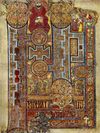
The Book of Kells.
|
Literature and the arts
For an island of relatively small population, Ireland has made a disproportionately large contribution to world literature in all its branches, mainly in English. Poetry in Irish represents the oldest vernacular poetry in Europe with the earliest examples dating from the 6th century; Jonathan Swift, still often called the foremost satirist in the English language, was wildly popular in his day for works such as Gulliver's Travels and A Modest Proposal, and he remains so in modern times. More recently, Ireland has produced four winners of the Nobel Prize for Literature: George Bernard Shaw, William Butler Yeats, Samuel Beckett and Seamus Heaney. Although not a Nobel Prize winner, James Joyce is widely considered one of the most significant writers of the 20th century; Samuel Beckett himself refused to attend his own Nobel award ceremony, in protest of Joyce not having received the award. Joyce's 1922 novel Ulysses is considered one of the most important works of Modernist literature, and his life is celebrated annually on June 16 in Dublin as the Bloomsday celebrations.
The early history of Irish visual art is generally considered to begin with early carvings found at sites such as Newgrange. It is traced through Bronze age artifacts, particularly ornamental gold objects, and the religious carvings and illuminated manuscripts of the mediæval period. During the course of the 19th and 20th centuries, a strong indigenous tradition of painting emerged, including such figures as John Butler Yeats, William Orpen, Jack Yeats and Louis le Brocquy.
Modern Irish literature is still often connected with its rural heritage, though writers like John McGahern and poets like Seamus Heaney. There is a thriving performing arts culture in many Irish centres, most particularly in Galway.
Music and dance
The Irish tradition of folk music and dance is also widely known. In the middle years of the 20th century, as Irish society was attempting to modernise, traditional music tended to fall out of favour, especially in urban areas. During the 1960s, and inspired by the American folk music movement, there was a revival of interest in the Irish tradition. This revival was led by such groups as The Dubliners, The Chieftains, The Wolfe Tones, the Clancy Brothers, Sweeney's Men, and individuals like Seán Ó Riada and Christy Moore. Irish and Scottish traditional music share some similar characteristics.
Before too long, groups and musicians including Horslips, Van Morrison, and Thin Lizzy were incorporating elements of traditional music into a rock idiom to form a unique new sound. During the 1970s and 1980s, the distinction between traditional and rock musicians became blurred, with many individuals regularly crossing over between these styles of playing as a matter of course. This trend can be seen more recently in the work of artists like U2, Enya, Flogging Molly, Moya Brennan, The Saw Doctors, Bell X1, Damien Rice, The Corrs, Aslan, Sinéad O'Connor, Clannad, The Cranberries, Rory Gallagher, Westlife, B*witched, BoyZone, Gilbert O'Sullivan, Black 47, VNV Nation, Wolfe Tones, Ash, The Thrills, Stars of Heaven, Something Happens, A House, Sharon Shannon, Damien Dempsey, Declan O' Rourke, The Frames and The Pogues.
During the 1990s, a subgenre of folk metal emerged in Ireland that fused heavy metal music with Irish and Celtic music. The pioneers of this subgenre were Cruachan, Primordial and Waylander.
Irish music has shown an immense increase in popularity with many attempting to return to their roots. Some contemporary music groups stick closer to a "traditional" sound, including Altan, Teada, Danú, Dervish, Lúnasa, and Solas. Others incorporate multiple cultures in a fusion of styles, such as Afro Celt Sound System and Kíla.
The Republic of Ireland has done well in the Eurovision Song Contest, being the most successful country in the competition, with seven wins in 1970 with Dana, 1980 and 1987 with Johnny Logan, 1992 with Linda Martin, 1993 with Niamh Kavanagh, 1994 with Paul Harrington and Charlie McGettigan and in 1996 with Eimear Quinn.
Sport
The most popular sports in Ireland are Gaelic Football and Association Football. Together with Hurling and Rugby, they make up the four biggest team sports in Ireland. Gaelic Football is the most popular in terms of match attendance and community involvement, and the All-Ireland Football Final is the biggest day in Ireland's sporting calendar. Association football, meanwhile, is the most commonly played team sport in Ireland and the most popular sport in which Ireland fields international teams Furthermore, there is a large measure of Irish interest in the English and (to a lesser extent) Scottish soccer leagues. Many other sports are also played and followed, particularly golf and horse racing but also show jumping, greyhound racing, swimming, boxing, basketball, cricket, fishing, handball, motorsport, tennis and hockey.
Hurling and Gaelic football, along with camogie, ladies' Gaelic football, handball and rounders, make up the national sports of Ireland, collectively known as Gaelic games. All Gaelic games are governed by the Gaelic Athletic Association (GAA), with the exception of ladies' Gaelic football and Camogie, which are governed by separate organisations. The GAA is organised on an all-Ireland basis with all 32 counties competing. The headquarters of the GAA (and the main stadium) is located at the 82,500 capacity Croke Park in north Dublin. Major GAA games are played there, including the semi-finals and finals of the All-Ireland Senior Football Championship and All-Ireland Senior Hurling Championship. During the redevelopment of the Lansdowne Road stadium, international rugby and soccer are also being played there. All GAA players, even at the highest level, are amateurs, receiving no wages (although they are allowed to receive a certain amount of income from sources such as sponsorship, grants or scholarships).
The Irish Football Association (IFA) was originally the governing body for Association football throughout the island. The game has been played in Ireland since the 1860s ( Cliftonville F.C. of Belfast being Ireland's oldest club, but remained a minority sport outside of Ulster until the 1880s. However, some clubs based outside Belfast felt that the IFA largely favoured Ulster-based, Protestant clubs in such matters as selection for the national team. Following an incident in which, despite an earlier promise, the IFA, for security reasons, moved an Irish Cup final replay from Dublin to Belfast, the clubs based in what would soon become the Free State set up a new Football Association of the Irish Free State (FAIFS) - now known as the Football Association of Ireland (FAI) - in 1921.
Despite being initially blacklisted by the Home Nations' associations, the FAI was recognised by FIFA in 1923 and organised its first international fixture in 1926 (against Italy. However, both the IFA and FAI continued to select their teams from the whole of Ireland, with some players earning international caps for matches with both teams. Both also referred to their respective teams as "Ireland". In 1950, FIFA directed the associations only to select players from within their respective territories, and in 1953 FIFA further clarified that the FAI's team was to be known only as " Republic of Ireland", and the IFA's team only as " Northern Ireland" (with certain exceptions).
Northern Ireland qualified for the World Cup finals in 1958 (reaching the quarter-finals), 1982 and 1986. The Republic qualified for the World Cup in 1990 (reaching the quarter-finals), 1994, 2002 and the European Championships in 1988. The IFA still retains all-Ireland cups and trophies at its Belfast HQ.
The Irish rugby team includes players from north and south, and the Irish Rugby Football Union governs the sport on both sides of the border. Consequently in international rugby, the Ireland team represents the whole island. The Irish rugby team have played in every Rugby World Cup, making the quarter-finals at four of them. Ireland also hosted games during the 1991 Rugby World Cup and the 1999 Rugby World Cup (including a quarter-final). There are also four professional provincial sides that contest the Magners League and European Heineken Cup. Irish rugby has become increasingly competitive at both the international and provincial levels since the sport went professional in 1994. During that time, Ulster (1999) and Munster (2006) have both won the European Cup.
As with rugby and Gaelic games, cricket, golf, tennis, rowing, hockey and most other sports are organised on an all-island basis.
Greyhound racing and horse racing are both popular in Ireland: greyhound stadiums are well attended and there are frequent horse race meetings. The Republic is noted for the breeding and training of race horses and is also a large exporter of racing dogs. The horse racing sector is largely concentrated in the central east of the Republic.
Boxing is also an all-island sport governed by the Irish Amateur Boxing Association. In 1992 Michael Carruth won a gold medal for boxing in the Olympic Games in Barcelona.
Irish athletics has seen some development in recent times, with Sonia O' Sullivan winning Gold at the World Championships in 1995 in the 5,000 metres and Silver in the 2000 Olympics in Sydney at the same distance. Gillian O'Sullivan winning silver in the 20k walk at the World Championship's in 2003 and sprint hurdler Derval O'Rourke taking gold at the World Indoor Championships in Moscow in 2006.
Golf is a popular sport in Ireland and golf tourism is a major industry. The 2006 Ryder Cup was held at The K Club in County Kildare. Padraig Harrington became the first Irishman since Fred Daly in 1947 to win the British Open at Carnoustie in July 2007.
In 2007, the Irish cricket team was among the associate nations which qualified for the 2007 Cricket World Cup. The Irish team defeated Pakistan and finished second in its pool, earning a place in the Super 8 section of the competition.
The west coast of Ireland, Lahinch and Donegal Bay in particular, have popular surfing beaches; being fully exposed to the fury of the Atlantic Ocean. Surfing in Ireland attracts surfers aiming to catch Europe's largest waves. Donegal Bay is shaped like a funnel and catches West/South-West Atlantic winds, creating good surf - especially in winter. In recent years, Bundoran has hosted European championship surfing. The south-west of Ireland, such as the Dingle Peninsula and Lahinch also have surf beaches.
Scuba diving is increasingly popular in Ireland with clear waters and large populations of sea life, particularly along the western seaboard. There are also many shipwrecks along the coast of Ireland, with some of the best wreck dives being in Malin Head and off the County Cork coast.
With thousands of lakes, over 14,000 kilometres (8,700 mi) of fish bearing rivers, and over 3,700 kilometres (2,300 mi) of coastline, Ireland is a popular angling destination. The temperate Irish climate is suited to sport angling. While salmon and trout fishing remain popular with anglers, salmon fishing in particular received a boost in 2006 with the closing of the salmon driftnet fishery. Coarse fishing continues to increase its profile. Sea angling is developed with many beaches mapped and signposted, and in recent times the range of sea angling species has increased.
Places of interest
Some interesting places to visit on the island of Ireland include the following:
- The Aran Islands, Co. Galway
- Blarney Castle, Co. Cork
- Bunratty Castle, Co. Clare
- The Burren, Co. Clare
- Cahir Castle near Cahir, Co Tipperary
- Carrickfergus Castle, Co. Antrim
- Clonmacnoise Co. Offaly
- Croagh Patrick, Co. Mayo
- Cliffs of Moher, Co. Clare
- Walled City of Derry
- Dingle Peninsula, Co. Kerry
- The Giant's Causeway, Co. Antrim
- Glendalough, Co. Wicklow
- The Glens of Antrim, Co. Antrim
- Glenveagh National Park, Co. Donegal
- Grianan of Aileach, Co. Donegal
- Hill of Tara, Co. Meath
- Killarney National Park, Co. Kerry
- Kilkenny Castle, Co. Kilkenny
- King John's Castle (Limerick)
- Knock Shrine, Co. Mayo
- Kylemore Abbey, Co. Galway
- The Mourne Mountains, Co. Down
- Newgrange, Co. Meath
- Phoenix Park, Co. Dublin, the largest enclosed urban public park in Europe.
- The Rock of Cashel, Co. Tipperary
- Skellig Michael, Co. Kerry
- Tory Island, Co. Donegal
- Trim Castle, Co. Meath
- Trinity College, Dublin, Co. Dublin. Houses the Book of Kells
- The Wicklow Way, Co. Wicklow
Modern architecture
In the 20th century, Irish architecture followed the international trend towards modern, sleek and often radical building styles, particularly after independence in the first half of the century. New building materials and old were utilised in new ways to maximise style, space, light and energy efficiency. 1928 saw the construction of Ireland's first all concrete Art Deco church in Turners Cross, Cork. The building was designed by Chicago architect Barry Byrne and met with a cool reception among those more accustomed to traditional designs.
In 1953, one of Ireland's most radical buildings, Bus Éireann's main Dublin terminal building, better known as Busáras, was completed. It was built despite huge public opposition and excessive costs of over £1 million. Michael Scott, its architect is now considered one of the most important architects of the twentieth century in Ireland.
A significant change in Ireland's architecture has taken place over the last few years, with a major shift towards the European continental ethos of architecture and urbanity. There are currently four buildings in planning that would eclipse the country's current tallest building record - currently held by Cork County Hall in Cork. These projects include the Elysian Building in Cork and the U2 Building, Players Mill and The Tall Building in Dublin. One of the most symbolic structures of modern Irish architecture is the Spire of Dublin. Completed in January 2003, the structure was nominated in 2004 for the prestigious Stirling Prize.
Demographics
Ireland has been inhabited for at least 9,000 years, although little is known about the paleolithic and neolithic inhabitants of the island (other than by inference from genetic research in 2004 that challenges the idea of migration from central Europe and proposes a flow along the Atlantic coast from Spain). Early historical and genealogical records note the existence of dozens of different peoples that may or may not be "mythological" ( Cruithne, Attacotti, Conmaicne, Eóganachta, Érainn, Soghain, to name but a few).
During the past 1,000 years or so, Vikings, Normans, Scots and English have all added to the indigenous gene pool.
Ireland's largest religious group is the Catholic Church (over 73% for the entire island, and about 86.8% for the Republic), and most of the rest of the population adhere to one of the various Protestant denominations. The largest is the Anglican Church of Ireland. The Irish Muslim community is growing, mostly through increased immigration (see Islam in Ireland). The island also has a small Jewish community (see History of the Jews in Ireland), although this has declined somewhat in recent years. Over 4% of the Republic's population describe themselves as of no religion.
Ireland has for centuries been a place of emigration, particularly to England, Scotland, the United States, Canada, and Australia, see Irish diaspora. With growing prosperity, Ireland has become a place of immigration instead. Since joining the EU in 2004, Polish people have been the largest source of immigrants (over 150,000) from Central Europe, followed by other immigrants from Lithuania, the Czech Republic and Latvia.
Ireland's high standard of living, high wage economy and EU membership attract many migrants from the newest of the European Union countries: Ireland has had a significant number of Romanian immigrants since the 1990s. In recent years, mainland Chinese have been migrating to Ireland in significant numbers. Nigerians, along with people from other African countries have accounted for a large proportion of the non-European Union migrants to Ireland.
Ireland is multilingual but predominantly English-speaking, with Irish, the first official language of the Republic, the second most commonly spoken language. In the North, English is the de facto official language, but official recognition is afforded to both Irish and Ulster-Scots language. All three languages are spoken on both sides of the border. In recent decades, with the increase of immigration on an all-Ireland basis, many more languages have been introduced, particularly deriving from Asia and Eastern Europe, such as Chinese, Polish, Rusian, Turkish and Latvian.
Cities
After Dublin (1.7m in Greater Dublin), Ireland's largest cities are Belfast (800,000) in Greater Belfast), Cork (380,000 in Greater Cork), Derry (94,329 in Derry Urban Area), Limerick (93,321 incl. suburbs Limerick urban area), Galway (71,983), Lisburn (71,465), Waterford (49,240 including suburbs), Newry (27,433), Kilkenny (23,967 incl. suburbs) and Armagh (14,590).
Transport
Air
There are five main international airports in Ireland: Dublin Airport, Belfast International Airport (Aldergrove), Cork Airport, Shannon Airport and Ireland West Airport (Knock) . Dublin Airport is the busiest airport in Ireland, carrying over 22 million passengers per year; a new terminal and runway is now under construction, costing over €2 billion. All provide services to Great Britain and continental Europe, while Belfast International, Dublin, Shannon and Ireland West (Knock) also offer a range of transatlantic services. Shannon was once an important stopover on the trans-Atlantic route for refuelling operations and, with Dublin, is still one of the Ireland's two designated transatlantic gateway airports.
There are several smaller regional airports: George Best Belfast City Airport, City of Derry Airport (Eglinton), Galway Airport, Kerry Airport (Farranfore), ( Knock), Sligo Airport (Strandhill), Waterford Airport, and Donegal Airport (Carrickfinn). Scheduled services from these regional points are mostly limited to the rest of Ireland and Great Britain.
Airlines in Ireland include: Aer Lingus (the national airline of Ireland), Ryanair (Europe's largest low cost airline), Aer Arann and CityJet.
Rail
The rail network in Ireland was developed by various private companies, some of which received (British) Government funding in the late 19th century. The network reached its greatest extent by 1920. The broad gauge of 1,600 mm (5 ft 3 in) was eventually settled upon throughout the island, although there were also hundreds of kilometres of 914 mm (3 ft) narrow gauge railways.
Long distance passenger trains in the Republic are managed by Iarnród Éireann (Irish Rail) and connect most major towns and cities across the country.
In Dublin, two local rail networks provide transportation in the city and its immediate vicinity. The Dublin Area Rapid Transit (DART) links the city centre with coastal suburbs, while a new light rail system named Luas, opened in 2004, transports passengers to the central and western suburbs. Several more Luas lines are planned as well as an eventual upgrade to metro. The DART is run by Iarnród Éireann while the Luas is being run by Veolia under franchise from the Railway Procurement Agency (R.P.A.).
Under the Irish government's Transport 21 plan, reopening the Navan- Clonsilla rail link, the Cork- Midleton rail link and the Western Rail Corridor are amongst plans for Ireland's railways.
In Northern Ireland, all rail services are provided by Northern Ireland Railways (N.I.R.), part of Translink. Services in Northern Ireland are sparse in comparison to the rest of Ireland or Britain. A large railway network was severely curtailed in the 1950s and 1960s (in particular by the Ulster Transport Authority). The current situation includes suburban services to Larne, Newry and Bangor, as well as services to Derry. There is also a branch from Coleraine to Portrush. Waterside Station in Derry is the main railway station for Derry as well as County Donegal in Ireland, which no longer has a rail network.
Ireland also has one of the largest dedicated freight railways in Europe, operated by Bord na Móna. This company has narrow gauge railways totalling 1,930 kilometres (1,200 miles).
Roads
Motorists must drive on the left in Ireland, as in Great Britain, Australia, New Zealand, India, Hong Kong, Japan, and a number of other countries. Tourists driving on the wrong side of the road cause serious accidents every year. The island of Ireland has an extensive road network, with a (developing) motorway network fanning out from Belfast, Cork and Dublin. Historically, land owners developed most roads and later Turnpike Trusts collected tolls so that as early as 1800 Ireland had a 16,100 km (10,000 mi) road network.
In recent years the Irish Government has launched Transport 21 which plans to deliver a world class transport infrastructure system to Ireland. The project is the largest investment ever in Ireland's transport system with €34 billion being invested from 2006 until 2015. Work on a number of projects has already commenced while a number of objectives have already been completed. The Transport 21 plan can largely be divided into five categories, Metro / Luas, Heavy rail, roads, buses and airports. The plan for Transport 21 was announced on 1 November 2005 by the then Minister for Transport, Martin Cullen.
The year 1815 marked the inauguration of the first horsecar service from Clonmel to Thurles and Limerick run by Charles Bianconi. Now, the main bus companies are Bus Éireann in the Republic and Ulsterbus, a division of Translink, in Northern Ireland, both of which offer extensive passenger service in all parts of the island. Dublin Bus specifically serves the greater Dublin area, and a further division of Translink called Metro, operates services within the greater Belfast area. Translink also operate Ulsterbus Foyle in the Derry Urban Area.
All speed limit signs in the Republic changed to the metric system in 2005. Some direction signs still show distance in miles. Use of imperial measurements are usually limited to pints of beer in pubs, and informal measurement of human height ( feet and inches) and weight (usually stones, but pounds and ounces for infants). However, younger generations tend to use metric units more so than the older generations.
Energy network
For much of their existence electricity networks in the Republic of Ireland and Northern Ireland were entirely separate. Both networks were designed and constructed independently, but are now connected with three interlinks and also connected through Britain to mainland Europe. The Electricity Supply Board (ESB) in the Republic drove a rural electrification programme in the 1940s until the 1970s.
Ireland, north and south has faced difficulties in providing continuous power at peak load. The situation in the North is complicated by the issue of private companies not supplying NIE with enough power, while in the South, the ESB has failed to modernise its power stations. In the latter case, availability of power plants has averaged 66% recently, one of the worst such figures in Western Europe.
The natural gas network is also now all-Ireland, with an interconnector from Antrim to Scotland, and a further two interconnectors from Dublin to Britain. Most of Ireland's gas now comes through the interconnectors with a decreasing supply from the Kinsale field. The Corrib Gas Field off the coast of County Mayo has yet to come online, and is facing some localised opposition over the controversial decision to refine the gas onshore.
There have been recent efforts in Ireland to use renewable energy such as wind energy with large wind farms being constructed in coastal counties such as Donegal, Mayo and Antrim. What will be the world's largest offshore wind farm is currently being developed at Arklow Bank off the coast of Wicklow. It is predicted to generate 10% of Ireland's energy needs when it is complete. These constructions have in some cases been delayed by opposition from locals, most recently on Achill Island, some of whom consider the wind turbines to be unsightly. Another issue in the Republic of Ireland is the failure of the aging network to cope with the varying availability of power from such installations. The ESB's Turlough Hill is the only energy storage mechanism in Ireland.
Economy
In the 1920s and early 1930s, the Republic of Ireland pursued a low-tax, low-spending, non-interventionist approach under the government of W. T. Cosgrave and Cumann na nGaedhael, focused mainly on agriculture, with livestock farming of primary importance. The only notable expense the government went to during this time was for the rural electrification scheme, which saw £5,000,000 spent in constructing the Ardnacrusha hydroelectric power station on the river Shannon (also known as the Shannon Scheme). During this period, 97% of trade was done with Britain. This government favoured free-trade. However many saw this as inadequate after the Wall Street Crash of 1929.
In 1932, Eamonn De Valera's Fianna Fáil party defeated Cosgrave's party with a solid majority. De Valera's policy was of economic nationalism, a belief in self-sufficiency, and attempted industrialization. Fianna Fáil abandoned free trade and put up protective tariffs on almost all manufactured products. In June, 1932 De Valera withheld land annuities, which dated back to the land acts of the 18th and early 19th century, which were until then paid to the British Government. Britain responded by placing tariffs on Irish exports of livestock and by-products. In turn De Valera imposed duties on British coal. This developed into an 'economic war' known as the Anglo-Irish Trade War. The economic war resulted in widespread hardship for Irish farming, which was the backbone of the economy, and which relied on exports to English cities for a market. The tariffs resulted in price increases for many essential manufactured goods, and an increase in the cost of living. High unemployment in richer English speaking countries made emigration from Ireland less of an option, decreasing wages. At this time many Irish industries were established, based of low wages, and protectionist barriers. With the British anticipating war, and the Irish in a dire financial situation, the trade war ended in 1938, with the British agreeing to discontinue land annuity payments from Irish farmers. Fianna Fáil established many semi-state organizations for the purposes of utilizing national resources, and marshalling larger scale industries. At this time the Irish economy enjoyed a stable period.
Fianna Fáil remained in power until 1948, when the first coalition government ousted them. To the present day, the two largest parties, Fianna Fáil and Fine Gael, have dominated the scene, Fine Gael traditionally being seen as less interventionist in economic matters. Fianna Fáil have become less interventionist and more market driven in the early 1990s, especially when in alliance with the small pro-business party, the Progressive Democrats.
Northern Ireland experienced a boom during World War II, as a result of demand for its principal industries, shipbuilding and linen making, and got a lot of support from the British government thereafter. In comparison, Ireland did not experience a WWII boom and its situation declined relative to Northern Ireland. In the 1950s there was a dramatic decrease in the population of working age, as workers picked up better paid jobs in Britain and North America. This was a period of great concern, with considerable social heamorrhaging taking place in rural Ireland in particular. In the early 1960s, the new Fianna Fáil leader Seán Lemass abandoned its previous protectionist policies, and embarked on a programme of economic reform. Serious efforts were made to attract inward investment from the United States in particular, and to a lesser extent West Germany, and Japan. Purpose built industrial estates were developed in most large towns. Rural Electrification, the division of large estates, and agricultural scientific education resulted in dramatic increases in agricultural output in the 1960s. In 1972, second level education was made free and compulsory. Ireland applied to join the European Economic Community, gaining entry in 1973 along with Britain.
From 1973 to 1983, the island of Ireland was hit by two oil crises, a series of bank strikes that paralysed business activity for 18 months, poor industrial relations, public pay rises, and runaway inflation. However, poor management of the state finances was being addressed with repeated increases in taxation of all beneficial activity, until employment became less attractive than welfare. At the same time it was found that Irish industry was completely unprepared for competition that arose as a result of free trade with continental Europe. Ireland's heavy industries, located primarily in Cork, almost disappeared between 1982 and 1984. Agriculture, the only sector of the economy which was competitive at this stage, was constrained by production quotas, and prevented from taking up the slack in the economy. At the same time Ireland was producing its first generation where university education was widely attained. There was mass unemployment, with many people with tertiary education working minimum wage jobs or being out of work. Emigration returned to 50,000 per year. From 1982 to 1986 the national debt had doubled, mostly due to stabilisation policies like welfare, gigantic subsidies to semistate organisations and public utilities, and an effort to reduce inflation and stabilise the currency.
This situation changed dramatically in the mid 1990s as the result of a prodigious economic boom, known as the " Celtic Tiger" (as in " tiger economy"). This was led by a surge in inward investment in high end industries in services, and lower taxation levels. From 2002, this was augmented by low interest rates set by the European Central Bank which encourage private sector consumption. In July 2006, a survey undertaken by Bank of Ireland Private Banking showed that, of the top 8 leading OECD nations, the Republic of Ireland was ranked the second wealthiest per capita country in the world, showing an average wealth per head of nearly €150,000 (~ $190,000). This is behind Japan, and ahead of other countries such as the United States, United Kingdom and Germany.
Education in Ireland is free at all levels, including college (university).
In 2005, Ireland was ranked the best place to live in the world, according to a " quality of life" assessment by Economist magazine. The country's combination of increasing wealth and traditional values gives it the conditions most likely to make its people happy, the survey found. These conditions include health, freedom, unemployment, family life, climate, political stability and security, gender equality and family and community life. The Economist said: "Ireland wins because it successfully combines the most desirable elements of the new, such as low unemployment and political liberties, with the preservation of certain cosy elements of the old, such as stable family and community life."
The rosy reports and GDP figures mask several underlying imbalances. The construction sector, which is inherently cyclical in nature, now accounts for a significant component of Ireland's GDP. This was being driven by low interest-rates and the fact that Ireland is one of the few countries in the OECD not to have residential housing or water rates. A recent downturn in residential property market sentiment has highlighted the over-exposure of the Irish economy to construction, which now presents a threat to economic growth. Several successive years of unbalanced economic growth have also led to huge inequality between the strata of Irish society (see Economy of the Republic of Ireland - Recent developments), as well as significant environmental degradation, including rapid loss of biodiversity and erosion of natural and cultural heritage , and the highest per-capita rise in greenhouse gas emissions in the European Union since the Kyoto Protocol came into effect .
